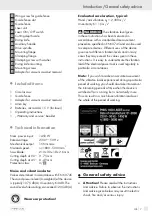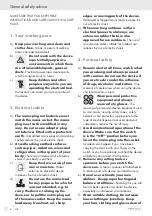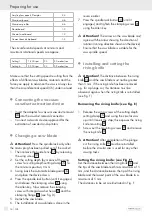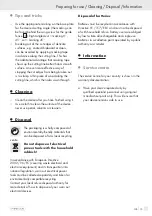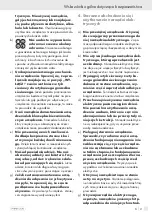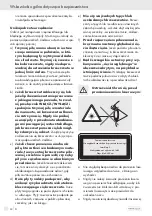
10 GB
Attention! To avoid the
risk of injury:
a)
Keep your hands away from the
area around the saw and clear of
the saw blade. Hold the auxiliary
handle or the motor housing with
your free hand.
If you have both hands on
the saw they cannot be injured by the saw blade.
b)
Do not grip the underside of the
workpiece.
The blade guard cannot protect
you from the saw blade under the workpiece.
c)
Set the cutting depth to match the
thickness of the workpiece.
Less than
a full tooth height should be visible below the
workpiece.
d)
Never hold the workpiece in your
hand or steady it with your leg
whilst sawing. Keep the workpiece
steady on a stable supporting
surface.
It is important to see that the
workpiece is firmly held in place to minimise
any danger of it making contact with your body,
jamming of the saw blade or loss of control.
e)
Hold the device by the insulated
handle surfaces when you are
undertaking work where there is the
danger of the cutting tool striking
hidden electricity cables or the
device‘s mains lead.
Contact with a live
wire means that the metal parts of the device
may also become live and this can result in an
electric shock.
f)
When cutting longitudinally always
use a guide fence or a straight edge
guide.
This will improve the accuracy of your
cut and reduce the risk of the blade jamming.
g)
Always use a saw blade of the
correct size and with the appropriate
central fixing hole bore.
Saw blades
that do not correspond with the attachment
components on the saw will not run true and
could lead to loss of control.
h)
Never use a damaged or incorrect
saw blade washer or screw.
The
saw blade washer and screw have been
specially designed to give your saw optimum
performance and safety in use.
What causes kickback and how to
avoid it:
a) A kickback is a sudden reaction to a saw
blade becoming hooked, jammed or
misaligned. This causes an out of control
circular saw to raise itself and move out of the
workpiece and towards the operator.
b) If the sawblade becomes hooked or trapped in
a narrowing saw gap, it is suddenly prevented
from rotating and the force of the motor throws
the device back in the direction of the operator.
c) If the sawblade distorts or becomes misaligned
in the saw cut, the teeth at the rear edge of
the sawblade may hook themselves into the
workpiece surface causing the sawblade to
move out of the saw gap and the circular
saw to jump backwards in the direction of the
operator.
Special safety advice for circular saws
and automatic blade guards
a)
Before you use the saw, always
check that the automatic blade
guard
6
closes properly. Do not use
the saw if the bottom compartment
of the blade guard does not move
freely or close immediately. Never
jam or tie the automatic blade guard
in the open position.
The bottom part of
automatic blade guard may become bent if the
saw falls on to the floor. Open the blade guard
with the release lever and make sure that it
moves freely and does not touch the saw blade
or other parts at all cutting angles and depths.
b)
Check that the spring on the
automatic blade guard functions
properly. If the automatic blade
guard or spring does not function
properly, have the device serviced
before you use it.
Damaged parts, sticky
deposits or accumulations of splinters can
delay the operation of the bottom blade guard.
c)
Open the automatic blade guard
by hand only for certain cuts such
as plunge or angle cuts. Open the
automatic blade guard with the
release lever and let it go again as
soon as the saw blade penetrates
General safety advice
Summary of Contents for PHKS 1450 LASER
Page 2: ...A F E D C B 10 13 6 11 12 4 9 1 2 3 4 5 6 7 8 14 13 15 22 17 16 21 20 19 18 22 23 24 ...
Page 28: ...30 ...
Page 52: ...54 ...
Page 64: ...66 ...
Page 88: ...90 ...





